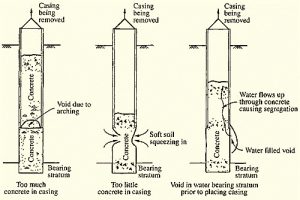 Determining the integrity of a material can be accomplished by intrusive or non-intrusive methods. Intrusive methods are more conventional, and include drilling, coring, or penetration via preinstalled conduits. These methods can include destructive testing (core samples) providing direct information about the condition of the structure under consideration, but may compromise the structural integrity once testing is completed.
Determining the integrity of a material can be accomplished by intrusive or non-intrusive methods. Intrusive methods are more conventional, and include drilling, coring, or penetration via preinstalled conduits. These methods can include destructive testing (core samples) providing direct information about the condition of the structure under consideration, but may compromise the structural integrity once testing is completed.
Integrity testing by non-intrusive methods is often more cost effective, but requires sophisticated equipment and specialty training to yield meaningful results. Non-destructive testing of piles has gained increased acceptance for various purposes including quality control/quality assurance, verification of existing conditions, and quantification of dimensions. The correct use of this technique can greatly simplify and expedite investigations. On the flip side, incorrect use can cause delays or adverse reputation for the technology.
ASTM D-5882 test method covers the procedure for determining the integrity of individual vertical or inclined piles by measuring and analyzing the velocity (required) and force (optional) response of the pile induced by a hand held hammer or other similar type impact device usually applied axially and perpendicularly to the pile head surface. This standard provides minimum requirements for low strain impact testing of piles.
This test method is applicable to long structural elements that function in a manner similar to any deep foundation units such as driven piles, augured piles, or drilled shafts, regardless of their method of installation provided that they are receptive to low strain impact testing.
The Pulse Echo Method is a surface reflection integrity testing technique. A high frequency accelerometer is attached to the pile top using a mild bonding agent such as petro wax or petroleum jelly. A lightweight hand held hammer (1 to 3 pounds) is used to strike the pile top and generate a small strain stress wave. Changes in the pile cross-section, concrete density, and/or soil resistance affect the impedance in the direction of the traveling wave and create reflections of the stress wave that propagate back towards the pile top. The quality of the result produced by this test method is dependent on the competence of the personnel performing it, and the suitability of the equipment and facilities used.

